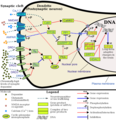파일:Annotated ΔFosB.svg screenshot.png

미리 보기 크기: 580 × 599 픽셀 다른 해상도: 232 × 240 픽셀 | 464 × 480 픽셀 | 743 × 768 픽셀 | 1,200 × 1,240 픽셀
원본 파일 (1,200 × 1,240 픽셀, 파일 크기: 399 KB, MIME 종류: image/png)
파일 설명
| 설명Annotated ΔFosB.svg screenshot.png |
English: This is a screenshot of the Wikitext-annotated variant of File:ΔFosB.svg as used in the English Wikipedia template en:Template:Psychostimulant addiction, without the notes in the top-right corner. For a description of what the diagram illustrates, follow the preceding link to the English Wikipedia template page. 
|
| 날짜 | 17 April 2015 (the SVG image revision was published on 21 July 2014) |
| 출처 | 자작 |
| 저자 | Joseph Mickel (Seppi333) |
| 저작권 (이 파일을 인용하기) |
Notice about new image licensing options: As of February 2020, this file has been multi-licensed to more broadly permit the reuse of this image within other media. The original licensing option was the CC-BY-SA-3.0 license. It is now available under all CC-BY-SA licenses as well as the more permissive CC-BY-4.0 license, which does not include the share-alike condition. |
| 다른 버전 | ■ File:ΔFosB.svg – unlabeled version |
| Related image files InfoField | ■ File:ΔFosB accumulation.svg – graphical illustration of how ΔFosB expression changes over time after drug exposure ■ File:TAAR1 Dopamine.svg – schematic illustration of how amphetamine induces the release of dopamine from dopaminergic axon terminals into the synapse via TAAR1 binding and collapsing the vesicular pH-gradient through VMAT2 |
라이선스
| This item is available under multiple licenses. When using it, you can choose which of the following licenses to use. Please make sure you respect the license terms of the license you choose, including any requirements and restrictions (such as attribution requirements and restrictions on commercial use). |

|
Helpful note: Creative Commons Attribution 4.0 International (the first licensing option below) is the most permissive license for republishing this image. None of the licensing options below require you to ask me for permission to republish this file (you already have it) or even notify me before doing so; I'm always happy to learn when/how others reuse media I've created though. |
나는 아래 작품의 저작권자로서, 이 저작물을 다음과 같은 라이선스로 배포합니다:
이 파일은 크리에이티브 커먼즈 저작자표시 4.0 국제 라이선스로 배포됩니다.
저작자표시: you may credit either User:Seppi333 or "Joseph Mickel" in the attribution line.
- 이용자는 다음의 권리를 갖습니다:
- 공유 및 이용 – 저작물의 복제, 배포, 전시, 공연 및 공중송신
- 재창작 – 저작물의 개작, 수정, 2차적저작물 창작
- 다음과 같은 조건을 따라야 합니다:
- 저작자표시 – 적절한 저작자 표시를 제공하고, 라이센스에 대한 링크를 제공하고, 변경사항이 있는지를 표시해야 합니다. 당신은 합리적인 방식으로 표시할 수 있지만, 어떤 방식으로든 사용권 허가자가 당신 또는 당신의 사용을 지지하는 방식으로 표시할 수 없습니다.
저작자표시: you may credit either User:Seppi333 or "Joseph Mickel" in the attribution line.
- 이용자는 다음의 권리를 갖습니다:
- 공유 및 이용 – 저작물의 복제, 배포, 전시, 공연 및 공중송신
- 재창작 – 저작물의 개작, 수정, 2차적저작물 창작
- 다음과 같은 조건을 따라야 합니다:
- 저작자표시 – 적절한 저작자 표시를 제공하고, 라이센스에 대한 링크를 제공하고, 변경사항이 있는지를 표시해야 합니다. 당신은 합리적인 방식으로 표시할 수 있지만, 어떤 방식으로든 사용권 허가자가 당신 또는 당신의 사용을 지지하는 방식으로 표시할 수 없습니다.
- 동일조건변경허락 – 만약 당신이 이 저작물을 리믹스 또는 변형하거나 이 저작물을 기반으로 제작하는 경우, 당신은 당신의 기여물을 원저작물과 동일하거나 호환 가능한 라이선스에 따라 배포하여야 합니다.
이 라이선스 중에서 목적에 맞는 것을 선택하여 사용할 수 있습니다.
설명
이 파일이 나타내는 바에 대한 한 줄 설명을 추가합니다
en:Template:Psychostimulant addiction
이 파일에 묘사된 항목
다음을 묘사함
17 4 2015
image/png
408,516 바이트
1,240 화소
1,200 화소
파일 역사
날짜/시간 링크를 클릭하면 해당 시간의 파일을 볼 수 있습니다.
| 날짜/시간 | 섬네일 | 크기 | 사용자 | 설명 | |
|---|---|---|---|---|---|
| 현재 | 2016년 11월 10일 (목) 05:27 |  | 1,200 × 1,240 (399 KB) | Seppi333 | forgot to remove the notes in the top right corner |
| 2016년 11월 10일 (목) 05:08 |  | 1,200 × 1,240 (409 KB) | Seppi333 | Updated screenshot to reflect recent changes to File:ΔFosB.svg and en:template:Psychostimulant addiction. | |
| 2015년 4월 17일 (금) 16:31 |  | 1,197 × 1,240 (615 KB) | Seppi333 | User created page with UploadWizard |
이 파일을 사용하는 문서
다음 문서 1개가 이 파일을 사용하고 있습니다:
이 파일을 사용하고 있는 모든 위키의 문서 목록
다음 위키에서 이 파일을 사용하고 있습니다:
- de.wikipedia.org에서 이 파일을 사용하고 있는 문서 목록
- pl.wikipedia.org에서 이 파일을 사용하고 있는 문서 목록
- zh.wikipedia.org에서 이 파일을 사용하고 있는 문서 목록
메타데이터
이 파일에는 카메라나 스캐너가 파일을 만들거나 디지털화하는 데 사용하기 위해 기록한 부가 정보가 포함되어 있습니다.
프로그램에서 파일을 편집한 경우, 새로 저장한 파일에 일부 부가 정보가 빠질 수 있습니다.
| 수평 해상도 | 37.8 dpc |
|---|---|
| 수직 해상도 | 37.8 dpc |